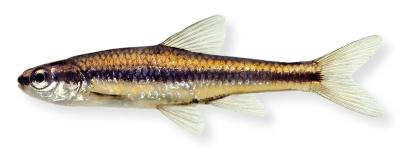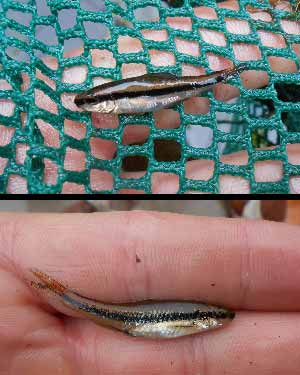Bridle Shiner
Notropis bifrenatus
 Distribution: Bridle shiners were once common in suitable habitat from the St. Lawrence River watershed to the Atlantic slope drainages from southern Maine to South Carolina.
Distribution: Bridle shiners were once common in suitable habitat from the St. Lawrence River watershed to the Atlantic slope drainages from southern Maine to South Carolina.
Description: The bridle shiner is a small minnow species with a black lateral band that extends from the tip of the snout, through the eye, back to the base of the tail. It is golden in color, with large, diamond shaped scales and a white underbelly. Bridle shiners may be confused with juvenile creek chubsuckers, which also have a prominent lateral band. The mouth of the creek chubsucker is sucker-like and pointed downward, compared to the mouth of the bridle shiner, which is positioned just below the tip of the snout. Juvenile creek chubsuckers, and most other minnow species, also have smaller scales than bridle shiners.
Species commonly confused with: Blacknose dace, juvenile creek chubsucker, juvenile fallfish
Habitat: Bridle shiners depend on dense communities of submerged aquatic vegetation for survival. This habitat may be found along the shorelines and coves of lakes and ponds, the backwaters of larger rivers, and in slow flowing streams.
Life History: The bridle shiner is a short lived species with a life span that rarely exceeds two years. Spawning bridle shiners congregate in open spaces above dense stands of aquatic plants. Spawning takes place in late spring and early summer. Aquatic vegetation with thick foliage, including Myrophyllum (milfoil), ceratophyllum (coontail), Nymphoides cordata (little floating heart), Utricularia (bladderwort), and chara (stonewort), appears to provide important spawning habitat for adults and nursery habitat for recently hatched juvenile bridle shiners. Bridle shiners feed on zooplankton and aquatic invertebrates. They move with a distinctive stop and start motion, rarely gliding like other minnow species such as the golden shiner, with which it is often observed. Bridle shiners forage in areas with little or no flow, usually suspended about midway between the surface and the bottom. They are often found in loose groups or clusters. When alarmed, individuals scatter rapidly among the vegetation.
Origin: Native

Conservation/Management: Bridle shiner populations have suffered significant declines over the last few decades. There is only one remaining population of bridle shiners in Pennsylvania, where the species was once considered abundant. Bridle shiners have been extirpated from the state of Maryland and from a number of waterbodies in Massachusetts. Despite an extensive survey effort, the New Hampshire Fish and Game Department (NHFGD) documented bridle shiners at only 6 of 21 sites where they were recorded as present in 1938. The reasons for the apparent extirpations from certain water bodies are not always clear and multiple causes are probable. In some waterbodies, including Winnisquam Lake, Canobie Lake, and Shadow Lake, submerged aquatic vegetation has been reduced to just a small fraction of the overall shoreline habitat. The loss of aquatic vegetation is a problem common to lakes and ponds with increasing levels of shoreline development. Even marginal reductions in aquatic vegetation may make bridle shiners more vulnerable to predators, both native and introduced. Bridle shiners are known to coexist with bass and other introduced predators, like black crappie, in water bodies with intact shoreline habitat.
Water level drawdown has the potential to extirpate bridle shiners from a waterbody. Water level drawdowns occur for dam maintenance, flood storage, dock repair for shoreline property owners, or vegetation control. Drawdowns during winter expose the roots of aquatic vegetation to dessiccation and freezing, causing temporary die back. The overall reduction in aquatic plants will impact bridle shiners during the growing season. Water level drawdowns during winter may have a direct effect on bridle shiners by preventing access to near shore habitat in the early spring. Bridle shiners have been observed using overhanging banks and shrubs as cover in late winter and early spring before the emergence of aquatic plants. Bridle shiners are extremely sensitive to unnatural water level fluctuations during the growing season, when spawning is occurring and juveniles seek refuge in shallow water among submerged aquatic plants. With a life span of only two years, a single draw down event could decimate an entire population.



